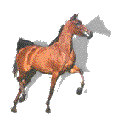Grass Founder, cause, what is it, treatment...
Why Grass Founder Occurs
Last week we discussed the condition known as grass founder. Actually founder can be caused by many different conditions, including hard riding and problems at foaling, as well as overeating. Most overeating is when Dobbin picks the lock to the feed room and gorges himself. Grass founder is a form of overeating, but is actually a merging of two conditions: obesity and a new supply of highly digestible grass. If the horse is in working condition it is very unlikely to founder on new grass. The obese horse, on the other hand, can founder on good quality hay or summer grass that has gone to seed. The heavy horse has a threshold where it is safe. This is when its nutrient intake matches the energy needs of its body.
As Dobbin ages, he may walk to water instead of run. As the level of activity slows, so does the body’s machinery, which further reduces the need for energy. As he becomes heavier he slows even more. The heavy horse has become so efficient he is able to store a great deal away in the form of fat. These storage areas can be seen over the ribs as saddle bags, across the rump, and most conspicuously forming a crest along the top of the neck. But the horse just keeps on eating!
After a winter of hay and hopefully very little grain, the new grass looks very appealing. It is also much more digestible than hay and pushes our patient over the threshold. After a few hours of grazing the body starts to react to the new grass like it would any foreign substance. This allergic reaction results in restriction of blood flow to the feet, which limits the oxygen supply to the tissue. Without oxygen the cells die and the tissue starts breaking down, allowing the coffin bone to pull away from the hoof wall. So here we are again, pulling our nails off.
With our understanding of what happens within the hoof, we can see how important proper trimming and/or shoeing are during the recovery phase. The coffin bone is connected by tendons to the rest of the leg. These tendons run from that bone up the back of the leg to various muscles. These same tendons are the ones flexing the leg when the horse walks or runs so we can see how strong they are. Each time the foot makes contact with the ground the tendons are drawn tight. Normally this gives spring to the step as the coffin bone is firmly attached to the hoof wall. But with inflammation of the foot, the tendons actually add to the discomfort by pulling the coffin bone away from the hoof. The longer the toe of the hoof, the greater the break over a period of time, which keeps tension on the coffin bone longer. A shorter toe allows the foot to break over more quickly and before the tendons are drawn tight.
As soon as the horse has been treated for the acute phase of founder, we turn our attention to the hoof. Trimming the toe very short will allow more comfortable walking. In more severe cases, shoeing with a flat shoe and preferably one with a worn toe, will protect the foot from contact with the ground. Additional doses of pain reliever or local nerve blocks may be necessary before the farrier can work on one foot while the horse supports all its weight on the other.
Just as this case of grass founder starts to fade as a bad memory we will be reminded of it a couple of ways. As the grass starts to respond to fall rains we will need to confine Dobbin to prevent him from eating himself into trouble again. He is even more susceptible now. He will have to be placed in a dry lot and fed low calorie (and low quality) hay. He needs this roughage for intestinal function but hopefully will burn more calories digesting it than it will provide. Exercise, diet restriction, a serious illness, or nursing a foal are the only ways to slim down the horses who has become obese.
CLICK BELOW TO DISPLAY A PRINTER-FRIENDLY COPY OF THIS ARTICLE
Select "Open this file from its current location," if you just want to print it out,
it will open in a simple word processing application, select the print button.
(unless you want to save this article in your computer's memory)

 WhyGrassFounderOccurs.rtf
WhyGrassFounderOccurs.rtf